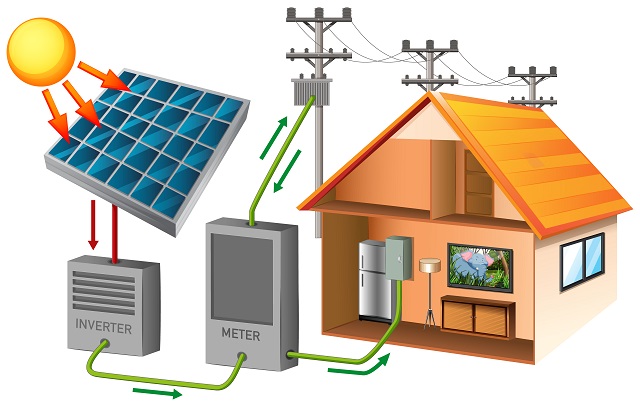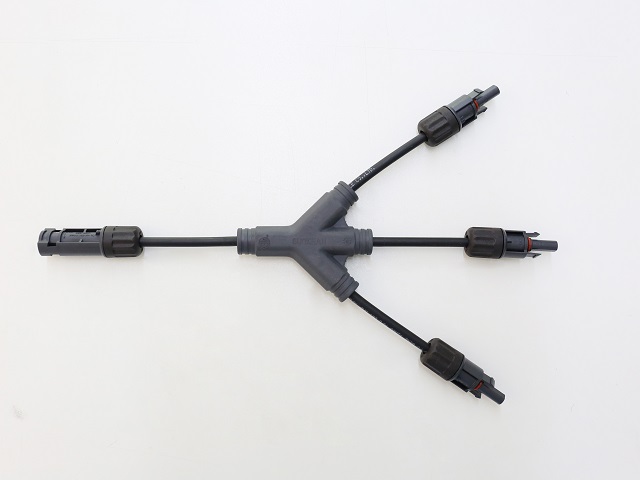I. Introduction

A. Importance of cables in solar energy systems
Solar cables serve as the physical link between various components of a solar energy system. They are responsible for carrying the direct current (DC) electricity generated by solar panels to the inverter, where it is converted into alternating current (AC) suitable for use in household appliances and the electrical grid.
B.Introduction to DC and AC solar cables
DC Solar Cables:
Direct current (DC) cables form the backbone of solar energy systems, serving as the conduit through which electricity flows from solar panels to the inverter for conversion into usable alternating current (AC) electricity. These cables are specifically designed to withstand the high voltages and currents generated by solar photovoltaic (PV) arrays while minimizing energy losses and ensuring safe and reliable operation.
AC Solar Cables:
In contrast, alternating current (AC) cables come into play once the electricity has been converted by the inverter, carrying the AC power from the inverter to the electrical loads within the home or facility and, in grid-tied systems, backfeeding excess electricity into the utility grid. These cables must meet stringent standards for voltage ratings, insulation, and safety to ensure seamless integration with the existing electrical infrastructure and compliance with regulatory requirements.
While the distinction between DC and AC cables may seem straightforward, the nuances lie in their design, construction, and performance characteristics. DC cables, for instance, are typically designed to handle higher voltages and currents than their AC counterparts, necessitating thicker insulation and specialized materials to withstand the rigors of outdoor exposure and environmental conditions.
On the other hand, AC cables must adhere to strict standards for impedance, capacitance, and inductance to minimize power losses and maintain power quality throughout the transmission and distribution process. This requires careful selection of materials, conductor sizes, and shielding techniques to optimize performance and reliability while ensuring compatibility with the inverter and other system components.
II. DC Solar Cables

A. Characteristics
Voltage Ratings: DC solar cables are designed to handle high voltages generated by solar photovoltaic (PV) arrays, typically ranging from 600 volts to 1500 volts or more. These voltage ratings are determined based on factors such as the size and configuration of the solar array, ambient temperature conditions, and regulatory requirements. Selecting cables with appropriate voltage ratings is critical for ensuring safe and reliable operation, minimizing the risk of electrical faults or failures.
Current Carrying Capacity: In addition to voltage ratings, DC solar cables must also be capable of carrying high currents generated by solar panels under varying operating conditions. The current carrying capacity of a cable is determined by factors such as its cross-sectional area, conductor material, and ambient temperature rating. Cables with larger conductor sizes and higher temperature ratings can handle greater currents without overheating or experiencing excessive voltage drops, thereby maximizing energy efficiency and system performance.
Insulation Requirements: Insulation is a critical aspect of DC solar cables, providing protection against electrical shock, short circuits, and environmental hazards. Cables used in solar energy systems must meet stringent insulation requirements to ensure safe and reliable operation under harsh outdoor conditions, including exposure to sunlight, moisture, and temperature fluctuations. Common insulation materials used in DC solar cables include cross-linked polyethylene (XLPE) and ethylene propylene rubber (EPR), which offer excellent electrical and mechanical properties while withstanding environmental stressors.
Durability and Weather Resistance: DC solar cables are subjected to a wide range of environmental conditions, including exposure to sunlight, rain, snow, wind, and temperature extremes. As such, they must be engineered to withstand these elements while maintaining optimal performance and reliability over time. Cables with UV-resistant insulation, corrosion-resistant conductors, and ruggedized construction are preferred for outdoor solar installations, ensuring long-term durability and weather resistance.
B. Connection to solar panels
Panel-to-Cable Connectors: At the heart of the connection between solar panels and DC solar cables are the panel-to-cable connectors, also known as junction boxes or combiner boxes. They are designed to securely fasten the cables to the panels while providing electrical isolation and protection against environmental hazards such as moisture, dust, and debris.
Cable Routing and Management: DC solar cables must be carefully routed from the panel-to-cable connectors to the main junction box or combiner box, ensuring sufficient clearance, support, and protection along the way. Cables should be secured using appropriate clamps, brackets, or cable ties to prevent sagging, chafing, or damage due to wind, vibrations, or thermal expansion. Additionally, care should be taken to avoid sharp bends, twists, or kinks in the cables, as these can increase resistance and reduce energy efficiency.
C. Inverter compatibility
Voltage and Current Ratings: DC solar cables must be capable of safely carrying the voltages and currents generated by the solar panels to the inverter without exceeding its maximum input specifications. Selecting cables with appropriate voltage ratings and current carrying capacities is essential for ensuring compatibility and avoiding potential damage to the inverter or electrical components.
Cable Length and Sizing: Inverter manufacturers typically provide guidelines and recommendations for cable sizing based on factors such as cable length, conductor material, and ambient temperature conditions. It's essential to adhere to these guidelines to ensure optimal performance and reliability, minimizing energy losses and maximizing power output.
Connection Methods and Protocols: In addition to voltage and current considerations, compatibility between DC solar cables and inverters may also involve the use of specific connection methods and communication protocols. Some inverters may require proprietary connectors or communication interfaces to facilitate data exchange, monitoring, and control functions.
III. AC Solar Cables

A. Characteristics
Voltage Ratings: AC solar cables are designed to carry electricity at standard household voltages, typically ranging from 110 volts to 240 volts for residential applications and higher voltages for commercial and industrial installations. The voltage rating of AC cables is determined by factors such as the size of the electrical loads, the distance of transmission, and regulatory requirements governing electrical installations.
Current Carrying Capacity: Similar to DC solar cables, AC solar cables must also be capable of carrying high currents generated by solar inverters under varying load conditions. The current carrying capacity of AC cables is influenced by factors such as conductor size, insulation rating, and ambient temperature conditions. Cables with larger cross-sectional areas and higher temperature ratings can handle greater currents without overheating or experiencing excessive voltage drops.
Insulation Requirements: Common insulation materials used in AC solar cables include polyvinyl chloride (PVC), cross-linked polyethylene (XLPE), and ethylene propylene rubber (EPR), which offer excellent electrical and mechanical properties while withstanding environmental stressors.
B. Connection to inverters
Inverter Input and Output Terminals: The connection between AC solar cables and inverters typically occurs at the input and output terminals of the inverter unit. The input terminals receive AC electricity from the solar panels via the DC to AC conversion process, while the output terminals deliver the converted AC electricity to the electrical loads within the home or facility and, in grid-tied systems, backfeed excess electricity into the utility grid.
Wiring Configuration and Sizing: The wiring configuration may vary depending on the design and layout of the solar energy system, with options for single-phase or three-phase connections to accommodate different load requirements and electrical distribution setups.
Conduit and Protection: Proper grounding and overcurrent protection devices should be installed to ensure the safety and integrity of the electrical system. Ground fault circuit interrupters (GFCIs), surge protectors, and other protective devices help to prevent electrical shocks, fires, and equipment damage in the event of a fault or surge in the electrical system.
C. Compatibility with grid-tie systems
Integration with Utility Grid: One of the defining features of grid-tie systems is their ability to connect directly to the utility grid, allowing surplus electricity generated by solar panels to be exported to the grid for credit or compensation. AC solar cables serve as the conduit through which this excess electricity is transmitted from the solar inverter to the utility grid, enabling bi-directional flow of power and seamless interaction between the solar energy system and the grid.
Voltage and Frequency Compatibility: AC solar cables used in grid-tie systems must be compatible with the voltage and frequency requirements of the utility grid to ensure safe and reliable operation. In most cases, this involves matching the voltage and frequency output of the solar inverter to the specifications of the utility grid, typically 120/240 volts AC at a frequency of 60 Hz in North America or 230 volts AC at a frequency of 50 Hz in Europe and other regions.
Grid Interconnection Standards: Grid-tie systems must comply with specific interconnection standards and regulations established by utility companies, regulatory agencies, and industry organizations to ensure the safety, reliability, and stability of the electrical grid. These standards typically include requirements for equipment certification, system design, protection schemes, and grid synchronization techniques to prevent adverse effects such as voltage fluctuations, frequency instability, and islanding events.
Net Metering and Feed-In Tariffs: AC solar cables play a crucial role in enabling net metering and feed-in tariff schemes by facilitating the bi-directional flow of electricity between the solar energy system and the utility grid. It's essential to ensure that AC solar cables are properly installed, sized, and configured to maximize energy production and optimize the economic benefits of grid-tie solar installations.
IV. Conclusion
If you are interested in high-quality cables and comprehensive after-sales service, welcome to visit SUNKEAN, where there are all kinds of latest cable products you need. If you have any needs, you can leave a message to our salesman, thank you for your coordination. Email: sales@sunkean.com
Tags :